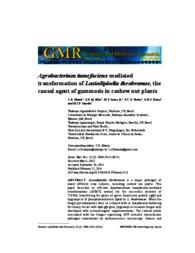Agrobacterium tumefaciens-mediated transformation of Lasiodiplodia theobromae, the causal agent of gummosis in cashew nut plants.
Agrobacterium tumefaciens-mediated transformation of Lasiodiplodia theobromae, the causal agent of gummosis in cashew nut plants.
Author(s): MUNIZ, C. R.; SILVA, G. F. da; SOUZA JUNIOR, M. T.; FREIRE, F. das C. O.; KEMA, G. H. J.; GUEDES, M. I. F.
Summary: Lasiodiplodia theobromae is a major pathogen of many different crop cultures, including cashew nut plants. This paper describes an efficient Agrobacterium tumefaciens-mediated transformation (ATMT) system for the successful delivery of T-DNA, transferring the genes of green fluorescent protein (gfp) and hygromycin B phosphotransferase (hph) to L. theobromae. When the fungal pycnidiospores were co-cultured with A. tumefaciens harboring the binary vector with hph-gfp gene, hygromycin-resistant fungus only developed with acetosyringone supplementation.
Publication year: 2014
Types of publication: Journal article
Unit: Embrapa Western Amazon
Observation
Some of Embrapa's publications are published as ePub files. To read them, use or download one of the following free software options to your computer or mobile device. Android: Google Play Books; IOS: iBooks; Windows and Linux: Calibre.
Access other publications
Access the Agricultural Research Database (BDPA) to consult Embrapa's full library collection and records.
Visit Embrapa Bookstore to purchase books and other publications sold by Embrapa.

